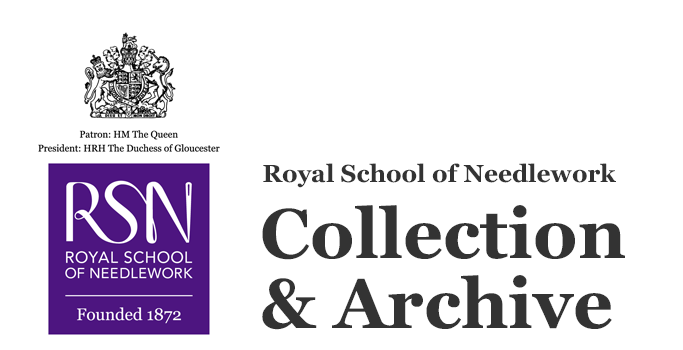Fragment
Object name
Date made
Maybe 19th century
Place made
Description
Fragment of velvet upon which is embroidered a tiny goldwork lion sat atop St Edward's Crown, possibly from the 19th century.
Content description
Small fragment of dark red velvet upon which is embroidered a goldwork lion on top of a crown. This may date to the 19th century, though it is difficult to determine with certainty. The lion has been rendered using cutwork techniques over some form of padding. On his head appears to be a small crown which is worked in couched gold pearl purl and satin stitched orange silk threads. The state of deterioration in this area make it difficult to determine materials with certainty. The lion is worked in gold pearl purl, silver purl pearl, and spangles. Stitches involved include flat cutwork, S-ing (at the tail), and couching. The lion, who has two eyes and a curling tail, is depicted baring its teeth.
The crown the lion stands upon features a purple velvet cap. The crown’s gold and silver frame has also been rendered primarily using cutwork techniques over padding. Bullion has been used to edge almost all the sections of flat cutwork aside from two fleur-de-lis which feature on the left and right side of the crown. The remainder of the goldwork is rendered in pearl purl. The pair of fleur-de-lis have also been worked in flat cutwork, with S-ing used at their base. Below the cap sits a row of four jewels, two depicted in green silk and two in orange silk. Above them is a row of cutwork in gold purl and below them is another band of cutwork in silver purl. These rows are bordered by couched bullion.
This fragment, with its crown and lion, is clearly tied to the British monarchy. The crown is likely meant to be St Edward’s Crown, which is the centrepiece of the Crown Jewels of the United Kingdom, named after Saint Edward the Confessor, the last Anglo-Saxon King of England. St Edward’s Crown has a purple velvet cap, much like the crown on this piece, as well as a solid gold frame set with rubies, amethysts, sapphires, garnet, topazes, and tourmalines. The crown is used in coronation ceremonies. The Royal Coat of Arms, to which this piece is connected, is used to identify who is Head of State and is used in the administration and government of the United Kingdom, including on coins, in churches and public buildings, and on the products and goods of royal warrant holders. It is not known what this fragment was originally part of, though it seems likely that it was once part of an item of royal dress or domestic furnishings.
The crown the lion stands upon features a purple velvet cap. The crown’s gold and silver frame has also been rendered primarily using cutwork techniques over padding. Bullion has been used to edge almost all the sections of flat cutwork aside from two fleur-de-lis which feature on the left and right side of the crown. The remainder of the goldwork is rendered in pearl purl. The pair of fleur-de-lis have also been worked in flat cutwork, with S-ing used at their base. Below the cap sits a row of four jewels, two depicted in green silk and two in orange silk. Above them is a row of cutwork in gold purl and below them is another band of cutwork in silver purl. These rows are bordered by couched bullion.
This fragment, with its crown and lion, is clearly tied to the British monarchy. The crown is likely meant to be St Edward’s Crown, which is the centrepiece of the Crown Jewels of the United Kingdom, named after Saint Edward the Confessor, the last Anglo-Saxon King of England. St Edward’s Crown has a purple velvet cap, much like the crown on this piece, as well as a solid gold frame set with rubies, amethysts, sapphires, garnet, topazes, and tourmalines. The crown is used in coronation ceremonies. The Royal Coat of Arms, to which this piece is connected, is used to identify who is Head of State and is used in the administration and government of the United Kingdom, including on coins, in churches and public buildings, and on the products and goods of royal warrant holders. It is not known what this fragment was originally part of, though it seems likely that it was once part of an item of royal dress or domestic furnishings.
Dimensions
width: 15cm
height: 12.5cm
height: 12.5cm
Materials
Stitches
Techniques
Motifs
Catalogue number
COL.79
Other numbers
RSN 2341
HC45
HC45
© Royal School of Needlework

